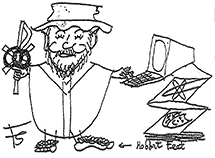In 1964 my wife and I and four children had a working holiday for three months in Britain and Ireland. We had almost no Canadian news in the British newspapers. Except for Honest Ed’s. The news was that Ed had offered free boxes of bathing suits to the first 100 who came into his store early one day. He would go one step further than the “topless” bathing suit fad and start a new fad: topless and bottomless. And the first 100 customers walked away with 100 empty boxes!
And the Brits thought Canadians were dull!
There’s often confusion about top and bottom. For example there’s a lot of talk about the “bottom line” being so important in business. But to a poor business the bottom line means the lowest income that the business can afford: to a thriving business it means the most big fat income that can be achieved!
Bishop John Robinson, around the time we were in Britain that year, published “Honest to God,” in which he scandalized some believers by saying that God is neither “up” nor “down.” Poor King Claudius, Prince Hamlet’s uncle, miserably admitting
‘My words fly up, my thoughts remain below,
Words without thoughts never to heaven go.’
And Mr. Khrushkev in Russia poked fun at Christians by saying that his cosmonauts had not been able to find God in the sky!
The basis of some of our “up and down” metaphor is that our head, with which we seem to think and certainly do talk, is above our feet and other parts of us which amble along closer to the ground. The head is the boss
(or thinks it is) and it is “up”.
We carry this metaphor into many things beside religion. We think of evolution as coming “up” from inorganic matter, to organisms, to plants, viruses, fish, animals, and humans. We also think of personal advance as coming up. Not just in social terms, top of the class, but what happens with some animals.
Gregory Bateson, a great anthropologist of the last century, experimented with dolphins and had them do more advanced experiments. Dolphins were trained to respond to more and more complex signals, and then were faced with no approval response from the signaller:
‘What happened next in this particular experiment was completely unexpected. The porpoise’s mind jumped to a higher logical type. The animal not only invented a new trick; it proceeded to perform four absolutely new capers that had never before been observed in this particular species of animal. The porpoise had become transcontextual. It had broken through the double-bind to what Bateson calls ”Learning III”. In Learning III we literally rise to a new level of existence, and then look down and recall our past consciousness, fraught with what we thought was irresolvable contradiction. “Oh yes,” we may say,” that’s what that was all about!”’(Morris Berman, “The Re-enchantment of the World,” 1981, 230-1)
Would that be a good metaphor for Jesus’ resurrection? And, remembering Kurt Godel: we cannot explain the resurrection of Jesus by reference alone to the world from which he “transcontextualized”!

